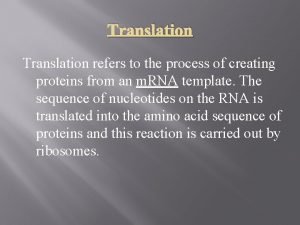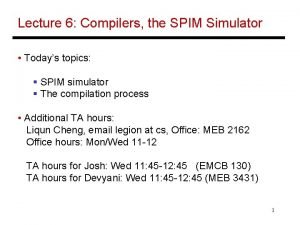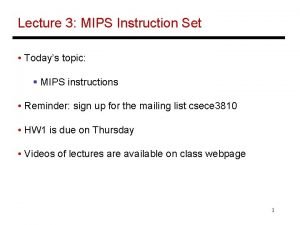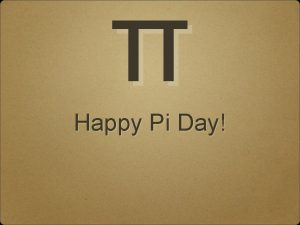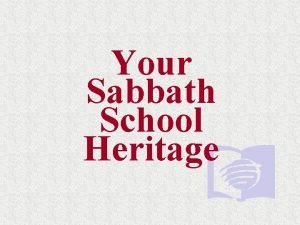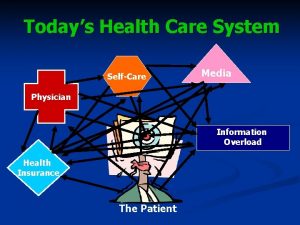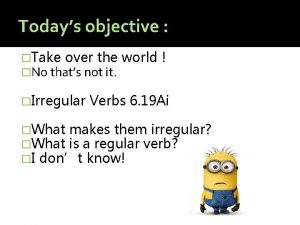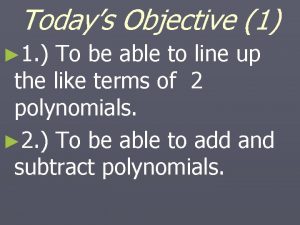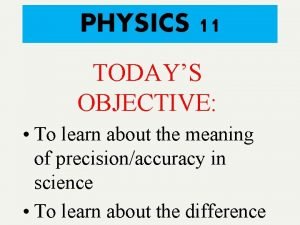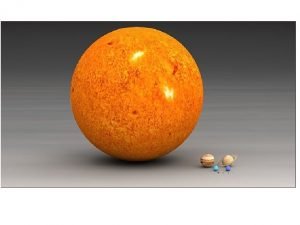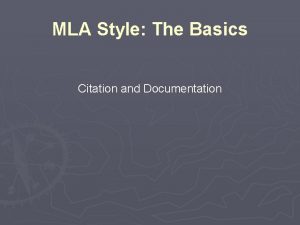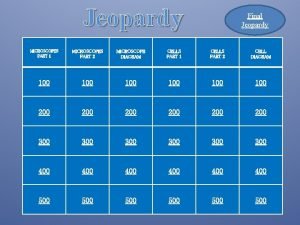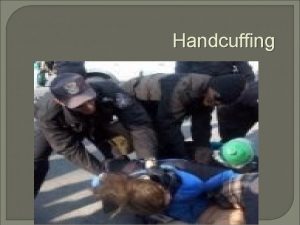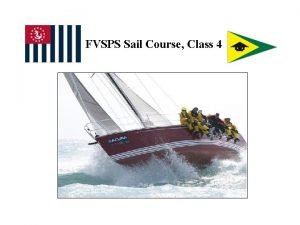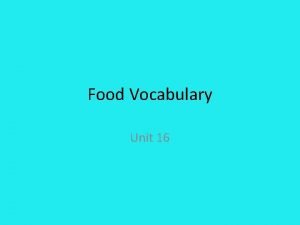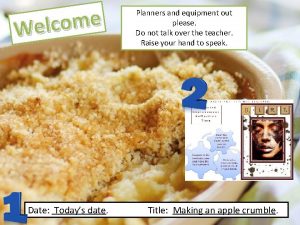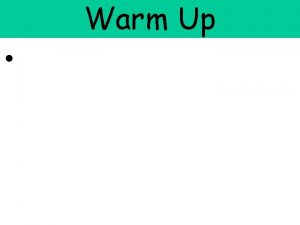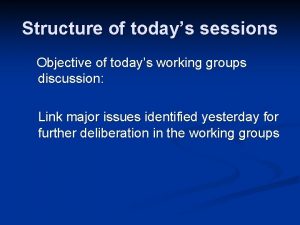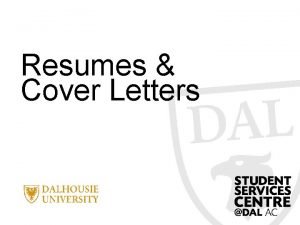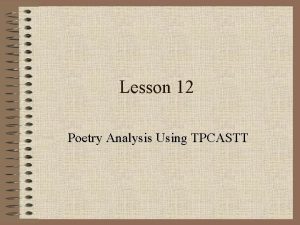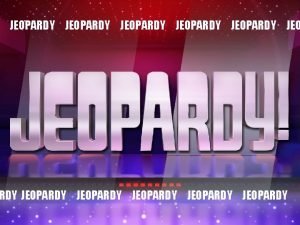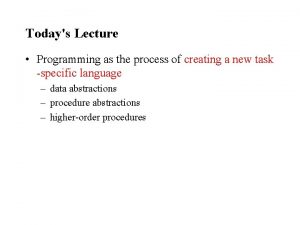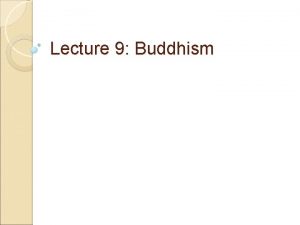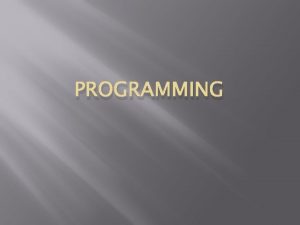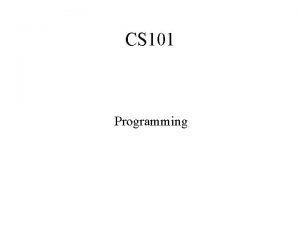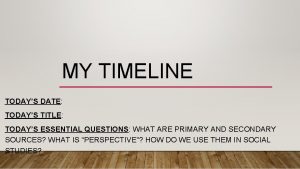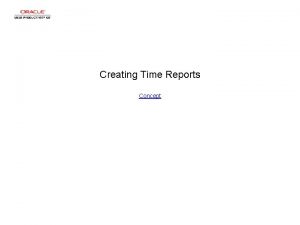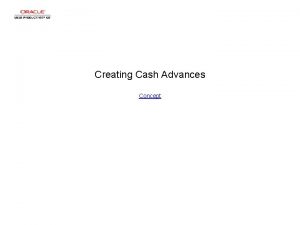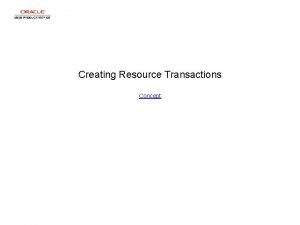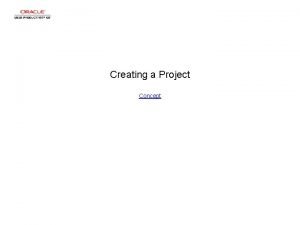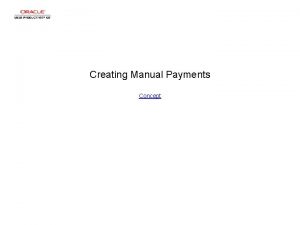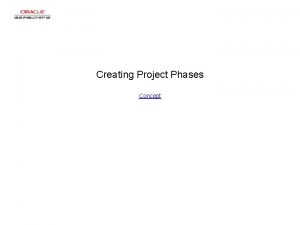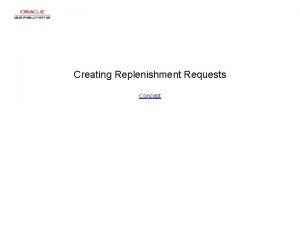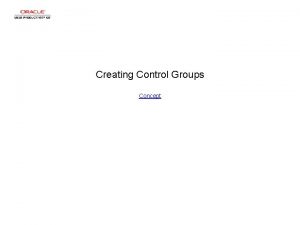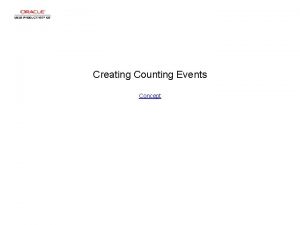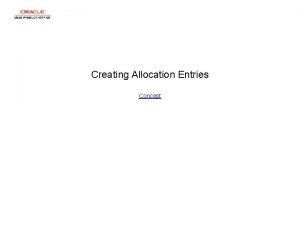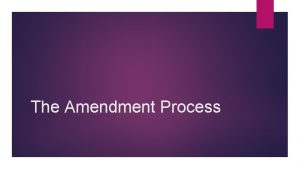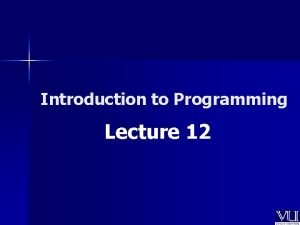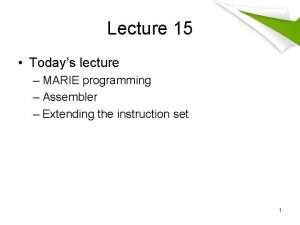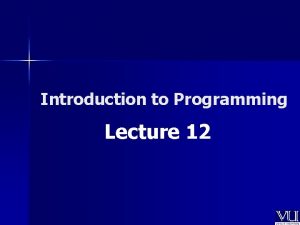Todays Lecture Programming as the process of creating










































- Slides: 42

Today's Lecture • Programming as the process of creating a new task -specific language – data abstractions – procedure abstractions – higher-order procedures

Themes to be integrated • Data abstraction – Separate use of data structure from details of data structure • Procedural abstraction – Capture common patterns of behavior and treat as black box for generating new patterns • Means of combination – Create complex combinations, then treat as primitives to support new combinations • Use modularity of components to create new, higher level language for particular problem domain

step 1: (forward 1) (no-opening-on-right? ) (goto step 1) (turn right 90) step 2: (forward 1) (no-opening-on-left? ) (goto step 2) step 3: (forward 1) (no-opening on left? ) (goto step 3) (turn left 90) (forward 1). . . RM (while no-opening-on-right (forward 1)) Go to first right Go to second left Go get me coffee, please. Level of language matters. Programming is a process of inventing task-specific languages.

Our target – the art of M. C. Escher ESCHER on ESCHER; Exploring the Infinite, p. 41 Harry Abrams, Inc. , New York, 1989

My buddy George


A procedural definition of George (define (george) (draw-line 25 0 35 50) (draw-line 35 50 30 60) (draw-line 30 60 15 40) (draw-line 15 40 0 65) (draw-line 40 0 50 30) (draw-line 50 30 60 0) (draw-line 75 0 60 45) (draw-line 60 45 100 15) (draw-line 100 35 75 65) (draw-line 75 65 60 65) (draw-line 60 65 65 85) (draw-line 65 85 60 100) (draw-line 40 100 35 85) (draw-line 35 85 40 65) (draw-line 40 65 30 65) (draw-line 30 65 15 60) (draw-line 15 60 0 85)) 100 00 Yuck!! Where’s the abstraction? 100

Need a data abstraction for lines (define p 1 (make-vect 2 3)) (2, 3) (5, 4) (xcor p 1) 2 (ycor p 1) 3 (define p 2 (make-vect 5 4)) (define s 1 (make-segment p 1 p 2)) (xcor (start-segment s 1)) 2 (ycor (end-segment s 1)) 4

(define p 1 (make-vect. 25 0)) (define p 2 (make-vect. 35. 5)) (define p 3 (make-vect. 3. 6)) (define p 4 (make-vect. 15. 4)) (define p 5 (make-vect 0. 65)) (define p 6 (make-vect. 4 0)) (define p 7 (make-vect. 5. 3)) (define p 8 (make-vect. 6 0)) (define p 9 (make-vect. 75 0)) (define p 10 (make-vect. 6. 45)) (define p 11 (make-vect 1. 15)) (define p 12 (make-vect 1. 35)) (define p 13 (make-vect. 75. 65)) (define p 14 (make-vect. 6. 65)) (define p 15 (make-vect. 65. 85)) (define p 16 (make-vect. 6 1)) (define p 17 (make-vect. 4 1)) (define p 18 (make-vect. 35. 85)) (define p 19 (make-vect. 4. 65)) (define p 20 (make-vect. 3. 65)) (define p 21 (make-vect. 15. 6)) (define p 22 (make-vect 0. 85)) A better George (define george-lines (list (make-segment p 1 p 2) (make-segment p 2 p 3) (make-segment p 3 p 4) (make-segment p 4 p 5) (make-segment p 6 p 7) (make-segment p 7 p 8) (make-segment p 9 p 10) (make-segment p 10 p 11) (make-segment p 12 p 13) (make-segment p 13 p 14) (make-segment p 14 p 15) (make-segment p 15 p 16) (make-segment p 17 p 18) (make-segment p 18 p 19) (make-segment p 19 p 20) (make-segment p 20 p 21) (make-segment p 21 p 22))) • Have isolated elements of abstraction • Could change a point without having to redefine segments that use it • Have separated data abstraction from its use

Gluing things together For pairs, use a cons: For larger structures, use a list: 1 2 3 4 (list 1 2 3 4) (cons 1 (cons 2 (cons 3 (cons 4 '() ))))

Properties of data structures • Contract between constructor and selectors • Property of closure: – consing anything onto a list produces a list – Taking the cdr of a list produces a list (except perhaps for the empty list)

Completing our abstraction Points or vectors: (define make-vect cons) (define xcor car) (define ycor cdr) Line segments: (define make-segment list) (define start-segment first) (define end-segment second)

Drawing in a rectangle or frame y axis (1, 1) origin (0, 0) x axis

Drawing lines is just algebra • Drawing a line relative to a frame is just some algebra. • Suppose frame has origin o, horizontal axis u and vertical axis v • Then a point p, with components x and y, gets mapped to the point: o + xu + yv y axis (1, 1) origin (0, 0) x axis

Manipulating vectors o + xu + yv +vect scale-vect

(define (+vect v 1 v 2) (make-vect (+ (xcor v 1) (xcor v 2)) (+ (ycor v 1) (ycor v 2)))) (define (scale-vect factor) (make-vect (* factor (xcor vect)) (* factor (ycor vect)))) Select parts Compute more primitive operation (define (-vect v 1 v 2) (+vect v 1 (scale-vect v 2 – 1))) Reassemble new parts (define (rotate-vect v angle) (let ((c (cos angle)) (s (sin angle))) (make-vect (- (* c (xcor v)) (* s (ycor v))) (+ (* c (ycor v)) (* s (xcor v)))))) What is the underlying representation of a point? Of a segment?

Generating the abstraction of a frame Rectangle: (define make-rectangle list) origin first) x-axis second) y-axis third) y axis Determining where to draw a point p: origin x axis o + xu + yv (define (coord-map rect) rect p) (lambda(origin (p) (+vect rect) (+vect (origin rect) (+vect (scale-vect (x-axis rect) (xcor p)) (scale-vect (y-axis rect) (ycor p))) )) )))

What happens if we change how an abstraction is represented? (define make-vect list) (define xcor first) (define ycor second) Note that this still satisfies the contract for vectors What else needs to change in our system? BUPKIS, NADA, NIL, NOTHING

What is a picture? • Maybe a collection of line segments? – That would work for George: (define george-lines (list (make-segment p 1 p 2) (make-segment p 2 p 3). . . )). . . but not for Mona • We want to have flexibility of what we draw and how we draw it in the frame – SO – we make a picture be a procedure (define some-primitive-picture (lambda (rect) draw some stuff in rect )) • Captures the procedural abstraction of drawing data within a frame

Creating a picture segments make-picture rect Picture proc picture on screen

The picture abstraction (define (make-picture seglist) (lambda (rect) Higher order procedure (for-each (lambda (segment) (let* ((b (start-segment)) (e (end-segment)) (m (coord-map rect)) (b 2 (m b)) (e 2 (m e))) (draw-line (xcor b 2) (ycor b 2) (xcor e 2) (ycor e 2)) seglist))) for-each is like map, except it doesn’t collect a list of results, but simply applies procedure to each element of list for its effect let* is like let, except the names are defined in sequence, so m can be used in the expressions for b 2 and e 2

A better George Remember we have george-lines from before So here is George! (define george (make-picture george-lines)) (define origin 1 (make-vect 0 0)) (define x-axis 1 (make-vect 100 0)) (define y-axis 1 (make-vect 0 100)) (define frame 1 (make-rectangle origin 1 x-axis 1 y-axis 1)) (george frame 1)

Operations on pictures V H’ rotate H O V’ O’

Operations on pictures (define george (make-picture george-lines)) (george frame 1) (define (rotate 90 pict) (lambda (rect) (pict (make-rectangle Pict (+vect (origin rect) ure (x-axis rect)) (y-axis rect) (scale-vect (x-axis rect) – 1)))) (define (together pict 1 pict 2) (lambda (rect) (pict 1 rect) (pict 2 rect)))

A Georgian mess! ((together george (rotate 90 george)) frame 1)

Operations on pictures Pict. A: Pict. B: beside above

Creating a picture beside Picture proc rect Picture proc picture on screen

More procedures to combine pictures: (define (beside pict 1 pict 2 a) (lambda (rect) (pict 1 (make-rectangle (origin rect) (scale-vect (x-axis rect) a) (y-axis rect))) (pict 2 (make-rectangle (+vect (origin rect) (scale-vect (x-axis rect) a)) (scale-vect (x-axis rect) (- 1 a)) (y-axis rect))))) Picture operators have a closure property! (define (above pict 1 pict 2 a) (rotate 90 3) ((repeated (rotate 90 (beside (rotate 90 pict 1) (rotate 90 pict 2) (beside (rotate 90 pict 1) a)))))) (rotate 90 pict 2) a))))))f n) (define (repeated (if (= n 1) f (compose f (repeated f (- n 1)))))

Big brother (define big-brother (beside george (above empty-picture george. 5))

A left-right flip V V’ flip H H’ (define (flip pict) (lambda (rect) (pict (make-rectangle (+vect (origin rect) (x-axis rect)) (scale-vect (x-axis rect) – 1) (y-axis rect)))))

(define acrobats (beside george (rotate 180 (flip george)). 5)) (define rotate 180 (repeated rotate 90 2))

(define 4 bats (above acrobats (flip acrobats). 5))

Recursive combinations of pictures (define (up-push pict n) (if (= n 0) pict (above (up-push pict (- n 1)) pict. 25)))

Pushing George around

Pushing George around (define (right-push pict n) (if (= n 0) pict (beside pict (right-push pict (- n 1)). 75)))

Pushing George into the corner (define (corner-push pict n) (if (= n 0) pict (above (beside (up-push pict n) (corner-push pict (- n 1)). 75) (beside pict (right-push pict (- n 1)). 75). 25)))

Pushing George into a corner (corner-push 4 bats 2)

Putting copies together (define (4 pict p 1 r 1 p 2 r 2 p 3 (beside (above ((repeated rotate 90 r 1) ((repeated rotate 90 r 2). 5) (above ((repeated rotate 90 r 3) ((repeated rotate 90 r 4). 5)) r 3 p 4 r 4) p 1) p 2) (define (4 same p r 1 r 2 r 3 r 4) (4 pict p r 1 p r 2 p r 3 p r 4)) p 3) p 4) (4 same george 0 1 2 3)

(define (square-limit pict n) (4 same (corner-push pict n) 1 2 0 3)) (square-limit 4 bats 2)



“Escher” is an embedded language Scheme data Picture language Primitive data 3, #f, george nil george, mona, escher Primitive procedures +, map, … Combinations (p a b) cons, car, cdr together, beside, …, and Scheme mechanisms Abstraction Naming Creation (define …) (lambda …) rotate 90, flip, …
 01:640:244 lecture notes - lecture 15: plat, idah, farad
01:640:244 lecture notes - lecture 15: plat, idah, farad C data types with examples
C data types with examples Translation refers to
Translation refers to Perbedaan linear programming dan integer programming
Perbedaan linear programming dan integer programming Greedy vs dynamic
Greedy vs dynamic System programming definition
System programming definition Integer programming vs linear programming
Integer programming vs linear programming Programing adalah
Programing adalah Generations
Generations We have class today
We have class today Multiple choice comma quiz
Multiple choice comma quiz Todays worldld
Todays worldld What is todays temperature
What is todays temperature Todays globl
Todays globl Whats todays wordlw
Whats todays wordlw Chapter 13 marketing in todays world
Chapter 13 marketing in todays world Todays plan
Todays plan Todays sabbath lesson
Todays sabbath lesson Sabbath school welcome poems
Sabbath school welcome poems Midlands 2 west north
Midlands 2 west north Todays health
Todays health Todays objective
Todays objective Todays objective
Todays objective Today's objective
Today's objective Todays whether
Todays whether Todays vision
Todays vision Todays objective
Todays objective Todays planetary position
Todays planetary position Cover sheet mla
Cover sheet mla Todays final jeopardy answer
Todays final jeopardy answer Handcuffing techniques lesson plan
Handcuffing techniques lesson plan Todays weather hull
Todays weather hull Todays objective
Todays objective Wat is todays date
Wat is todays date Todays objective
Todays objective Digestive system of ruminants
Digestive system of ruminants Todays objective
Todays objective Todays objective
Todays objective Examples of resume objectives
Examples of resume objectives Todays agenda
Todays agenda Todays jeopardy
Todays jeopardy Good morning campers today's challenge is simple
Good morning campers today's challenge is simple Adam smith jeopardy
Adam smith jeopardy


